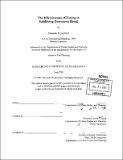The effectiveness of zoning in solidifying downtown retail
Author(s)
Jacobson, Alexandra B. (Alexandra Beth), 1972-
DownloadFull printable version (19.78Mb)
Other Contributors
Massachusetts Institute of Technology. Dept. of Urban Studies and Planning.
Advisor
Terry S. Szold.
Terms of use
Metadata
Show full item recordAbstract
Once the downtown was the regional hub of shopping, but the downtown retail sector has faced significant struggles to stay alive against the forces of suburban shopping malls, big box retailers, and the dominance of downtown office uses. Recognizing the importance of retail to provide services and bring vitality to the downtown, many cities in the United States have responded by modifying their zoning regulations. New regulations have introduced retail use requirements, street level design standards, and incentives to reward developers for incorporating retail spaces. By exploring examples in three U.S. cities, namely Washington D.C., Boston, and Seattle, this thesis looks at how effectively zoning has worked to solidify the downtown retail core and how other factors influence the existence, character and form of downtown retail. The case studies indicate that zoning is effective in creating an inventory of retail spaces and preventing other types of uses from migrating into areas targeted for retail. However, insufficient market demand can leave such spaces vacant for long periods of time until economic conditions change. Zoning can be an important tool in orienting retail to the street and improving the overall pedestrian environment. The zoning was most effective when it allowed a measure of flexibility in creating retail spaces of different sizes and forms, and when it was applied in an area with a predisposition for high pedestrian traffic and retail uses. Other factors beyond zoning play an important role in solidifying retail districts. Economic conditions that drive the development activity are the single most important factor determining whether the zoning is even activated. The city government plays a key role in catalyzing downtown investment. Often the guidance of a downtown management entity like a business improvement district is essential in shepherding a retail district. The overall population and density cannot be underestimated in importance from a retailer's perspective.
Description
Thesis (M.C.P.)--Massachusetts Institute of Technology, Dept. of Urban Studies and Planning, 2001. Includes bibliographical references (leaves 98-103).
Date issued
2001Department
Massachusetts Institute of Technology. Department of Urban Studies and PlanningPublisher
Massachusetts Institute of Technology
Keywords
Urban Studies and Planning.